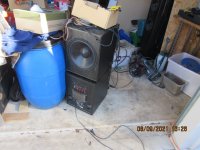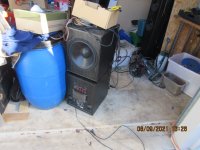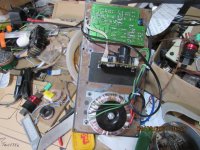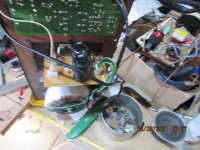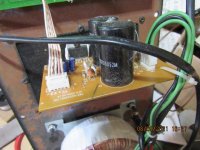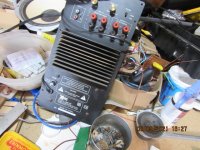All the cheap amplifiers in my H/T speakers are on the way out, several have died already and these cheap amps seem to not worth repairing even if the faults are minor.
I'm considering biting the bullet and converting them all from ported active to simple sealed passive.
I have no data for the drivers and still no test gear apart from the multimetre but the 12" are reasonably sized magnets with about 8mm of travel P2P and the tens are a very common generic with bigger magnets and lots of travel
Pix later.
Had these for a dozen years or more so I've got my monies worth from them but I see no need to trash if I can make them work passive.
Any tips; hints; pitfalls; advice for me before I start?
It will mean I have a dozen small toroid transformers [ maybe 150- 200VA] and associated heat sinks here that may have some small value
I'm considering biting the bullet and converting them all from ported active to simple sealed passive.
I have no data for the drivers and still no test gear apart from the multimetre but the 12" are reasonably sized magnets with about 8mm of travel P2P and the tens are a very common generic with bigger magnets and lots of travel
Pix later.
Had these for a dozen years or more so I've got my monies worth from them but I see no need to trash if I can make them work passive.
Any tips; hints; pitfalls; advice for me before I start?
It will mean I have a dozen small toroid transformers [ maybe 150- 200VA] and associated heat sinks here that may have some small value
Do you want to copy the current filters? You can use a computer with a soundcard, or your multimeter... or do you just want to start over?
I've been thinking of simply using as garage subs or as part of the party system so I'll be using an electronic XO [ Behringer ] for that.
It would be easier to make them sealed as far as rebuilding them goes
It would be easier to make them sealed as far as rebuilding them goes
Leave them vented, and just cut a wooden panel to fit in where the amp used to fit. And wire it with a speakon connector. Run an impedance test on the result, and use your DSP to insert a HP filter of 12~24dB/octave at the frequency where the first big peak appears in the impedance curve. Adjust to taste.
I think there is a communication breakdown. I was talking about using the computer for testing. I was going to outline a procedure for converting active subs to passive....now you say you want to use a Behringer.. what do you plan to do with it?
Allen I know I need a patch box to test with but other [ o= -1]items have taken priority.
I may not live long enough to afford a Woofer Tester
TBH for parties and Garage use they don't have to be perfect; just good enough.
I have a slew of old amplifiers in the shed and an old DJ mixer, output from the mixer goes to the Behringer CX3210 and I Bi-Amp the subs & tops.
Being a DJ mixer it has 12dB of gain on the inbuilt graphic equaliser and has bands at 20Hz/40/80 etc
I may not live long enough to afford a Woofer Tester
TBH for parties and Garage use they don't have to be perfect; just good enough.
I have a slew of old amplifiers in the shed and an old DJ mixer, output from the mixer goes to the Behringer CX3210 and I Bi-Amp the subs & tops.
Being a DJ mixer it has 12dB of gain on the inbuilt graphic equaliser and has bands at 20Hz/40/80 etc
I wasn't even thinking anything that fancy.. 😉
Ok, then I assume you're going to filter with the Behringer and don't need a passive filter..
Ok, then I assume you're going to filter with the Behringer and don't need a passive filter..
That's how I normally do things. As I upgrade my lounge room gear it becomes garage and party stuff, ans some of this old analogue stuff with flashing lights looks "cool"
Here are the pix of the dead subs and the chip amp that powered them
I'll take pix of the drivers tomorrow and measure DCR but I think they are 5.6 Ohms each
I'll take pix of the drivers tomorrow and measure DCR but I think they are 5.6 Ohms each
Attachments
Ported subs are easy to convert, simply replace the amp module with a piece of wood or aluminum with the driver wired directly to a speaker connector and drive it with an external amp, little no now EQ is necessary to get good results.. maybe a highpass to prevent unloading the driver below tuning. Sealed boxes are the same except that some EQ is necessary for flat response, but that also depends on positioning... if the sub is placed in a corner it may not need much.
I thought that ported tuning might change if the amp module takes up quite a bit of space.
Thinking about things I may just convert to sealed and use a bit more bass boost
Thinking about things I may just convert to sealed and use a bit more bass boost
It depends how the box is constructed, sometimes the amp module is sealed off from the sub enclosure other times it's not. A little more box volume will tend to lower reflex tuning slightly which isn't the worst thing to happen, but there are things you can do to consume some volume if it is an issue like glue a foam block onto the rear cover. Remember that the driver in a reflex enclosure may not be as suitable to a sealed alignment, it may be excursion limited to a lower output level. In any event don't overthink things, the simplest solution is often the best but don't be afraid to experiment either.
Last edited:
- Home
- Loudspeakers
- Subwoofers
- Converting active subs to passive query
